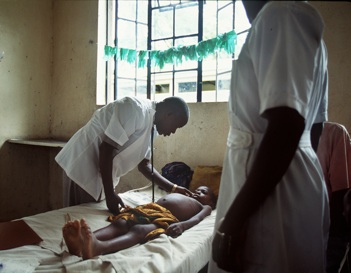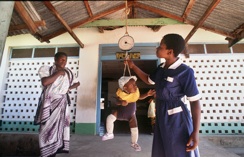When a father carries a child on his back in Tanzania, there is trouble.
That task is nearly always reserved for women, who use kangas - colorful bolts of fabric - to tie children to their bodies.
But the man walking the gritty path from the village of Mango is accompanied by no one except the diminutive, sickly child clinging to the curvature of his back. Both look road-weary and unstrung. The midday sun threatens to liquefy the sand underfoot, making each step a painful reminder that Tanzania nuzzles the equator.
The boy, a year or two old, lifts his head as if it is filled with water, and, overcome by the heaviness of it, drops it once again against his father's back. The boy's eyes are glassy and dilated, and he is losing the struggle to keep them open.
A Habitat for Humanity employee working in Liuli, Tanzania, stops the truck we are in. ''Mkwenda wapi?'' he asks the man in Swahili. After a short exchange, the man climbs into the truck, cradling the child.
''The child has cerebral malaria, the worst kind,'' our driver said. ''If he's not treated soon, he will die.''
The man has been walking four hours. His destination, St. Anne's, a hospital operated by the Anglican Church in Liuli, would have been another three hours on foot. A leisurely ride through the countryside suddenly becomes a mission of mercy.
Malaria is the biggest killer of children in the Lake Malawi region of Liuli. Three-quarters of the children who died at St. Anne's in 1994 had malaria. But the disease does not act alone. Unless coupled with pneumonia, anemia or other disease, malaria usually won't kill a child.
The disease, a parasitic infection transmitted by mosquitoes, is so endemic that people generally don't seek treatment for it. Having malaria is roughly the African equivalent of, say, contracting the flu: Everyone gets it, people miss work because of it, and the elderly and the young are more at risk.
The major difference: Malaria is a nuisance that can become a killer, and it never goes away.
The wards of St. Anne's Hospital could be called a microcosm of Africa's health. Cholera and Ebola, diseases that receive a lot of attention in the United States media but account for relatively few deaths in Africa, are absent. AIDS is on the rise. Outbreaks of meningitis, such as one that claimed 13 lives in 1993, can strike swiftly.
The hospital rooms are stark, but the inhabitants are hopeful. Beat-up metal-frame beds fitted with yellow foam mattresses line the walls of each of the facility's three wards. During the rainy season, when malaria-ridden mosquitoes are rife, children are laying two and three across in the beds. Mothers shuffle about the concrete floors in rubber thongs or bare feet, kicking about the dust that a woman with a broom struggles to contain.
In the distance, a chugging generator, the only source of electricity, announces that an operation is under way in the surgical theater. Modern technology dances a two-step with age-old tradition. It speaks volumes that the hospital that now has ultrasound equipment also washes and reuses latex gloves.
Dr. Samwel Ndimbo, wearing a white lab coat and a Rolex knockoff, walks the breezeway connecting the children's and women's wards. He is followed by a retinue of medical assistants in training and nurses wearing old-fashioned caps. The man gives a recitation on the problems of a late-stage pregnancy. For illustration, he uses the protuberant belly of a woman who looked ready to give birth yesterday.
Ndimbo is a doctor, a priest, a teacher and a savior to the people of Liuli. He's a modern icon in a world that operates pretty much as it did 500 years ago, except when it comes to medicine.
''My father and headmaster wanted me to become an Anglican priest,'' said Ndimbo, who was born and raised 5 miles from Liuli. ''Although I am ordained, my ministry now is medicine.''
In the hospital's administrative building, a wall of photographs chronicles the doctors who have run St. Anne's since it opened in 1906.
Ndimbo's portrait stands out; his predecessors were white mission doctors. He, alone, is Tanzanian and speaks Swahili and, more importantly, the local dialect. He, more than the others, understands the mindset of the impoverished subsistence farmer, who often seeks treatment from traditional healers before coming to the hospital.
In one breath, the doctor, in his mid-50s, lambasts the daughters of an elderly patient for not feeding the man adequate sources of protein. ''Anyone can get a goat for milking!'' he chastises. An argument nearly ensues before the women agree to get the milk. Moments later, Ndimbo privately lends 500 shillings to a patient who can't pay her bill.
St. Anne's is lucky to have Ndimbo. But not because Tanzania lacks trained doctors. The University of Dar-es-Salaam, in Tanzania's capital, graduates plenty of medical students each year; Ndimbo received his medical degree there in 1975. So why has the hospital for years been unable to fill two doctor positions?
''Nobody will come,'' said Ndimbo.
Like some rural areas in the United States, poor towns and hospitals in Tanzania can't match the lucrative salaries doctors receive in big cities. St. Anne's pays its doctors 37,000 Tanzanian shillings a month, about $67.
''A doctor can get 20,000 shillings for performing one C-section in Dar-es-Salaam. If he does 10, he gets that much more,'' Ndimbo said.
European doctors help by serving two- or three-year stints, funded by church organizations. Dr. Monica Gaffga, of Germany, has been working at St. Anne's since January 1995. Practicing medicine in a village that is at times accessible only by ferry requires patience and resolve, she said.
''A supply order of disposable needles takes three or four months to arrive. It takes up to six months to get lab results from Moshi or Dar-es-Salaam.''
And a little thing like bed sheets? Imagine having 100 beds to change without a washer and dryer.
But the hospital is adept at drawing out its resources, and its benefactors' purse strings. Bubble wrap, probably salvaged from supply shipments from London donors, is used to cushion babies in the preemie unit. A kitchen was built so that patients' families can cook meals for sick relatives, at a terrific savings to the hospital. Everyone treated is required to pay some kind of fee, even if it's in the form of a chicken or a goat. Patients are not allowed to check out until they have settled the bill.
Each week the staff of the 100-bed hospital, which is filled to overflowing in the rainy season, delivers an average of 20 babies, does two or three C-sections and might do operations ranging from intestinal surgery to appendectomies. As many as 10 blood transfusions are given a day during malaria season.
But there are limits. On a sticky day in February, Ndimbo and Gaffga, the German doctor, confer over X-rays in Ndimbo's modest brick office. Holding them up to the window light, Gaffga concedes, ''There's not much we can do for him, I'm afraid.''
The film shows a bone sheared just above the elbow and a gaping slice across the long bones of the hand. It was a hand caught in a crime tolerated by no one here, least of all by those whom the hand had stolen from. Thievery of any kind is dealt with sharply in this village - this time by a machete; but Ndimbo, shaking his head in concern, said this is the first violent street justice he's seen.
''Maybe it happens in Dar-es-Salaam. But not here,'' he said.
The swath left by the machete is more than the doctors are equipped to repair.
''We're not orthopedic surgeons,'' Gaffga said.
The doctors decide to send the man by Land Rover ambulance to a hospital four hours to the south. Perhaps the doctors there can set the bones; but it's unlikely the patient will again steal beer.
Making his early evening rounds in the men's ward, Ndimbo underscores an even more pernicious threat imported from big cities. He points to a man in his 20s reclining on a grayish sheet, cradling his legs to his chest. The patient's gaunt features are punctuated by immense eyes that turn to Ndimbo as he examines the man's chest X-ray.
''He is an AIDS patient,'' the doctor said in a hushed tone. ''The infection is in his lungs. He is almost finished.''
HIV infection is increasing at an astonishing rate in Tanzania. The World Health Organization estimates there are 840,000 people infected with the virus in the country, which has roughly three times the population of Ohio. The entire United States has an estimated 700,000 HIV-infected people.
The lakeshore region of Liuli is even more at risk because of the vast numbers of visitors from Malawi, a country that has a whopping 13 percent of its population living with HIV infection, according to 1994 WHO estimates.
Tracking exact numbers is unthinkable, Ndimbo said, because so many don't seek treatment for AIDS. Many die, in fact, thinking they have malaria, anemia or pneumonia.
But word is spreading about the menacing disease, which locals call mdudu, or, ''the bug.'' Hospital figures show that each year since 1993, roughly 100 patients seeking treatment tested positive for HIV. However, the number of healthy blood donors who tested positive for the virus doubled in 1995.
''If you get HIV in healthy people,'' Ndimbo said, ''then you know it's really a problem.''
For the man huddled in the men's ward, little can be done. ''We can only treat the symptoms,'' Ndimbo said. ''If he has diarrhea, you control the diarrhea; if he has high fevers, you treat the fevers. The special drugs you get in the U.S. to prolong life are just too expensive for us. If we can't even afford aspirin . . .'' His voice trails as he looks at a child bouncing on his mother's lap in the hospital common area.
''Our hope is to educate,'' Ndimbo says. ''We are trying to teach the people how it's contracted, how to prevent it, and how to care for those who have it.''
Very soon, the young man infected with mdudu will go home to his family to die.
But along the lakeshore another man strolls in the afternoon sun, looking to buy fish to feed his little charge back at the hospital. He recognizes a white man he met riding in the truck on the road from Mango. He motions a make-believe injection into his arm and points in the direction of the hospital. His young son has received treatment for the cerebral malaria and is recovering. He ambles off in the direction of fishing boats bringing in their catch, smiling as he goes.
For most, St. Anne's Hospital is a sanctuary for the sick, a healer of children and a restorer of hope. People are having fewer children - six instead of 10 or 12 - because parents no longer fear that all of their offspring will die from disease.
Ndimbo, who is nearing retirement age, said quitting his job is an option Liuli can't afford for him to take. ''I must continue. I must,'' he said.
''My joy is the appreciation of my people. When a patient you know comes back to you and says, 'Thank you, doctor. Thank you.' ''
The doctor bows his head and draws a long sigh to collect himself. ''That is really very satisfying. A doctor in Dar-es-Salaam doesn't get that the way I do.''
This article was published May 19, 1996, in the Columbus Dispatch.





